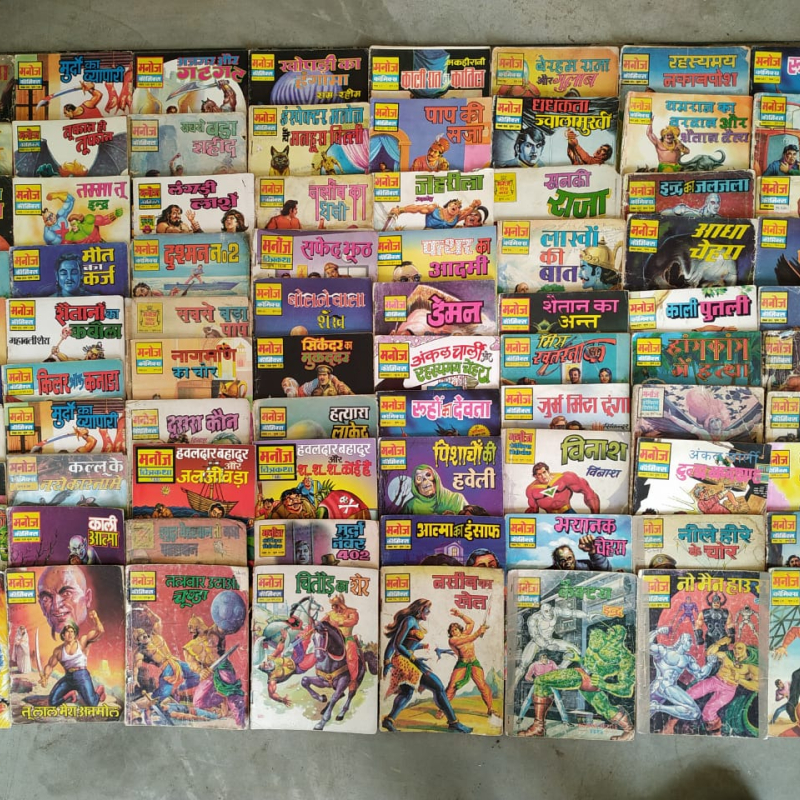The 1980s saw the ‘Americanization of the Indian superhero’.[1] It marked a clear break from Amar Chitra Katha’s tradition of using Hindu mythological characters as comic book heroes. This shift was due to the import liberalisation reforms that were taken up by successive central governments during the decade.[2]The economic liberalisation of 1991 only furthered the trend.
It is during this period that Raj Comics started publication. One of the most popular superheroes from the Raj Comics stable, Super Commando Dhruv, was created by veteran illustrator and writer Anupam Sinha in the year 1987. Sinha sketched this character with a certain audience in mind:
There were times when the term Superhero was synonymous to a person having paranormal powers, hiding behind an alter ego and in the age-range of 25. My thinking disagreed with these set norms. I had and still have a belief that a logical thinking brain is the greatest power in the world. For the second point of alter ego, I kept on reading excuses that it was to strike fear in the hearts of criminals and to protect those around her. The funny thing I found was, they had no one to protect! They were essentially orphans with no wife and kids. The only thing they could protect was they themselves. And a scared person himself cannot logically save others who are afraid... My third point was the age factor. I decided that kids could relate better with a hero in their own age group. And thus a hero got created having no freak superpowers, very young and with no alter ego. I took care to keep him lively with a very proper Indian family built on fun and respect! And thus, I presented Super Commando Dhruv to the masses.[3]
Dhruv made his first appearance in Pratishodh ki Jwala (The Fire of Vengeance, 1987) where the readers were introduced to the story of his origin. He was born to a couple, Radha and Shyam, who worked as trapeze artists in Jupiter Circus. They named him after the brightest star in the night sky—the pole star or dhruv tara. Dhruv grew up to become an expert bike rider, shooter, ringmaster, trapeze artist and bodybuilder. He was popular with humans and animals alike. The uniqueness of his talent lay in the power of communicating with animals and birds. This attracted the envy of the owner of Globe Circus who sent his henchman to set Jupiter Circus on fire. It destroyed the entire circus and resulted in the death of Dhruv’s parents. Thus was born a superhero who vowed to avenge his loss. The orphaned hero was adopted by a policeman’s family, and he decided to channel his rage to fight crime.
Dhruv, an ordinary man with exceptional physical and intellectual powers, was born out of India’s hybrid popular culture rather than a West–East transcreation.[4] Super Commando Dhruv treads a middle ground of cultural assimilation between the Americanisation of the Indian superhero and the Indianisation of the American superhero. Although he does not have a secret identity, Dhruv is Americanised in the sense that he has an iconic costume and is the custodian of the city of Rajnagar in the way Batman and Superman look after the cities of Gotham and Metropolis, respectively. It has been argued by fans that the character of Dhruv is a mix of Batman and Robin—his crime-fighting abilities resembling Batman’s, and his origin Robin’s.
A Humanised Superhero
Initial images from the early stages of his creation show him wearing a formal attire. Clad in a shirt and a pair of trousers, he looks like a clerk. Anupam Sinha later gave Dhruv a makeover and changed his attire to tights worn with boots as is customary for circus acrobats. This was in sync with his backstory. Initially, Sinha had planned that Super Commando Dhruv would debut with the comic book titled Roman Hatyara (The Roman Assassin, 1987) which was his first official case. But following the convention of introducing the character and then providing stories of their exploits, Sinha decided to present Dhruv to the readers through Pratishodh ki Jwala.
As a superhero, Super Commando Dhruv does not have an alter ego, which Sinha says was out of respect for the police who had to fight crime without the luxury of disguise.[5] He does not have any exceptional superpower either. Dhruv is a tall man with well-toned muscles. He is a brilliant strategist and an intelligent detective. To fight his enemies, he uses his intellect, gadgets (like signal flares, a multipurpose belt and nerve gas capsules) and objects around him. He also has a foster sister, Shweta Mehra, an up and coming scientist who creates a number of highly useful objects for Dhruv—including shoes that can turn into roller skates, star line (multipurpose rope) and a communication device called star transmitter. Interestingly, she is also a crime-fighter with an alter ego (Chandika) that Dhruv is not familiar with. As Shweta, she lends emotional support to Dhruv, and as Chandika, she comes to his aid whenever he is in danger.
Dhruv utilises the skills that he learnt at Jupiter Circus to fight crime in Rajnagar. He patrols the streets of Rajnagar on his bike during the night. Dogs and birds of Rajnagar are to Super Commando Dhruv what Baker Street Irregulars are to Sherlock Holmes. They act as observation towers and intelligence agents who inform him of any occurrence of criminal malpractice in the city. Dhruv has his own group of government-approved commando force of three young crime fighters: Peter, Renu and Karim.
Beyond the Trap of Superpowers
Super Commando Dhruv enjoyed massive fan following among children. They could relate to him because they saw him as a bigger and better version of themselves.[6] Due to his affable personality and circus skills, Dhruv became easily acceptable as a friend of the children. Sinha took the conscious decision of creating his superhero as a role model for young readers. This is why Dhruv eschews violence and uses it only as a last resort:
Children see the world very differently...every person seems like a giant to them and can do something that they cannot. Like taking out a jar of toffees from the cupboard. The adult is thus a superhero, because s/he can do something that the child cannot do. Tell me, when do you move out of reading comics? When you are an independent human being. Fantasy does not interest you all that much. The psychology of being dependant (sic.), of "I must have a person to protect me from any impending danger" is essentially a child’s psyche. That’s why I wrote this character Super Commando Dhruv.[7]
One of the biggest attractions of Super Commando Dhruv comic books is the presence of extraordinary supervillains. Notable among them are Grandmaster Robo, leader of a global crime syndicate, a half-human, half-cyborg who is immune to even mamba venom and can shoot laser beams from his left eye; Mahamanav who has psychic powers that can precipitate an ice age; Bauna Vaman, a mechanical buff who uses his expertise in remote-controlled gadgetry to terrorise humanity; Chandkaal, a mighty demon; Chumba who uses electromagnetic waves to paralyse his enemies; and Dhwani Raj who uses sonic waves as weapon. Dhruv stands in contrast to them. He is a compassionate superhero who allows villains the opportunity to redeem themselves. His lack of superpower also becomes his strength. Dhruv depends on his intellect to counter his enemies which makes his moves highly unpredictable.
The Arena of Action
Super Commando Dhruv’s Gotham, Rajnagar, is a malleable urban space with a rather interesting geography. It is a metropolis with skyscrapers, boulevards, nightclubs, bars, scientific institutions, museums, ghettos and abandoned housing spaces. However, Rajnagar also has a nuclear power plant, a seafront, tropical rainforests nearby and is not very far from a hot desert and the cold Himalayas. Sinha sees it as a replica of metropolises: ‘My cities are planned to have waterfronts, jungles, swamps, dense populations, dark narrow lanes, financial and scientific hubs—all with a possibility of evil. It’s not exactly New York or Mumbai but not too different either.’[8] It is a microcosm of the world which allows Dhruv to encounter the challenges posed by different climates, creatures and geographies without having to transcend national boundaries.
The peculiarities with which Dhruv was imagined made him an anomaly among his contemporaries. Though it was a gamble that paid off as he became one of the most popular superheroes not only in the Raj Comics universe but in the entire realm of Hindi comic books.
Notes
[1] Mathur, ‘From Capes to Snakes,’ 179.
[2]Ibid.
[3]Dhawan, ‘A Chat with Anupam Sinha.’
[4]Kaur and Eqbal, Adventure Comics.
[5]Ibid., 91.
[6]Ibid.
[7]Comic Con India, ‘Days of the Raj.’
[8]Kotamraju, ‘The Man Who made Them Superheroes.’
Bibliography
Mathur, Suchitra. ‘From Capes to Snakes: The Indianization of American Superhero.’ In Comics as a Nexus of Cultures: Essays on the Interplay of Media, Disciplines, and International Perspectives, edited by M. Berninger, J Ecke, and G. Haberkorn, 175–186. Jefferson, North Carolina and London: McFarland and Co., 2010.
Kaur, Raminder and Saif Eqbal. Adventure Comics and Youth Cultures in India. London and New York: Routledge, 2019.
Dhawan, Ananya. ‘A Chat with Anupam Sinha.’ eFiction India. 2013. Accessed August 9, 2019. http://www.efictionindia.in/2013/11/15/anupam-sinha/.
Kotamraju, Priyanka. ‘The man who made them superheroes.’ The Indian Express, New Delhi, October 28, 2012. Accessed August 9, 2019. http://archive.indianexpress.com/news/the-man-who-made-them-superheroes/1022940/0.
Comic Con India. ‘Days of the Raj—II (Super Commando Dhruv and Doga).’ Comic Con India. 2012. Accessed August 9, 2019.
https://web.archive.org/web/20120714011154/http://comicconindia.com/index.php?page=icj&blog-id=26.













